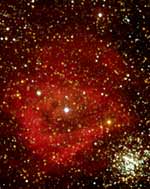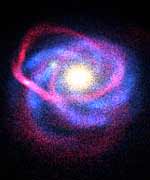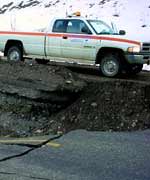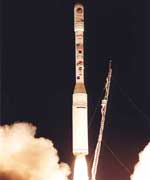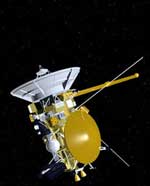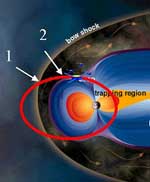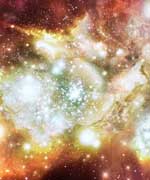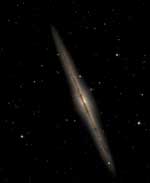
Image credit: UH IfA
Astronomers from the University of Hawaii’s Institute for Astronomy released new images from their brand new 16-megapixel camera installed on the 2.2 metre telescope on Mauna Kea. This new camera provides a tremendous increase in resolution over the 1-megapixel camera the telescope was using before, and makes this telescope one of the most powerful on Earth for Infrared astronomy. The newly-released image is of galaxy NGC 891, which is 10 million light-years away in the constellation of Andromeda.
Astronomers from the University of Hawaii (UH), Institute for Astronomy (IfA) today released the first image from a gigantic new 16 Megapixel infrared camera recently mounted on the UH 2.2-meter (88-inch) Telescope on Mauna Kea. The new camera provides a sixteen-fold increase in sky coverage together with much higher sensitivity than the 1-Megapixel cameras in widespread use on telescopes for the last decade. Until larger telescopes have similar cameras, it makes the 30-year-old UH 2.2-meter telescope the most powerful in the world for infrared imaging.
The development of this new technology has been driven by the requirements of NASA’s James Webb Space Telescope (JWST), the next step beyond the Hubble Space Telescope and planned for launch within ten years. This 6 meter class space telescope with six times the collecting area of Hubble will be launched into an orbit far beyond the moon where it will cool to temperatures of -400 degrees Fahrenheit, allowing extremely sensitive infrared observations. NASA has selected the UH/RSC (Rockwell Scientific Company) detector technology for the camera on JWST and is expected to adopt it for several other instruments.
Funded by a nearly $7 million award from NASA Ames Research Center, a team at the IfA Hilo facility headed up by Dr. Don Hall, former IfA director, has partnered with the Rockwell Scientific Company in Camarillo, CA, in a four year program to develop 4 Megapixel chips utilizing new infrared detector materials and state of the art silicon chips which, at a size of nearly 2″ x 2″, are some of the largest ever produced. In partnership with GL Scientific, a Honolulu small business, the team has innovated a new approach to mounting the individual 4 Megapixel chips so that four of them can be “tiled” into a 16 Megapixel camera. This approach allows for even larger “mosaic” cameras in the future.
Hall emphasized that the project was run from Hilo. “The IfA team provided technical direction of both the development effort at Rockwell Scientific and the silicon chip fabrication at the UMC foundry in Taiwan,” he said. “In addition, we have established in Hilo a facility to test these new detectors that is widely regarded as the best available”. Hall also commented “complex instruments like this camera usually require extensive de-bugging once they are mounted at the telescope. It is a tribute to the technical excellence of the IfA staff and the superb equipment at the IfA facility that this camera produced science data on its first night”.
The galaxy imaged, NGC 891, is in the constellation Andromeda at a distance of about 10 million light years. It is of particular scientific interest because it is very similar to our own Milky Way Galaxy but is seen almost exactly edge-on. Dr. Richard Wainscoat and Peter Capak, who are analyzing the image, emphasized the importance of being able to image the entire galaxy in a single exposure with the new camera. “With smaller cameras, galaxies such as NGC 891 had to be imaged in small postage stamp sized pieces that had to be painstakingly pieced together – the new camera produces a better image in a tiny fraction of the time,” Wainscoat said. “By allowing us to image very large areas of the sky, this camera will allow us to detect some of the most distant galaxies in the Universe”.
Along with the JWST, large ground based telescopes are already racing to take advantage of this new technology. Two Mauna Kea projects, the Canada-France-Hawaii Telescope and the Gemini Telescopes, are forging ahead with 16 Megapixel infrared cameras and Rockwell Scientific has orders for several other cameras for telescopes in Chile.
IfA Director Dr. Rolf Kudritzki said “This project is an excellent example of IfA’s nurturing of extremely high-tech projects in its Hilo facility and there is an institutional commitment to continued support of such activities. It is particularly gratifying that a number of the key personnel on this project grew up in Hilo and were recruited back from the Mainland and that several others were recruited directly as graduates of UH Hilo. The project also provided important training for undergraduate assistants from UH Hilo, many of whom have gone on to positions in related fields”.
The Institute for Astronomy at the University of Hawaii conducts research into galaxies, cosmology, stars, planets, and the Sun. Its faculty and staff are also involved in astronomy education, deep space missions, and in the development and management of the observatories on Haleakala and Mauna Kea. Refer to http://www.ifa.hawaii.edu/ for more information about the Institute.
Original Source: IFA News Release

